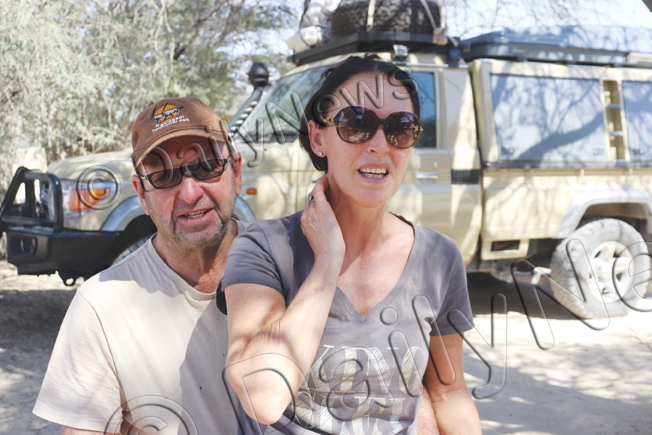Kgalagadi Transfrontier Park Tourists marvel
02 Oct 2024
Deep in the Kalahari Desert on the hoof of Botswana map lies a truly distinct wilderness landscape, a wildlife paradise and one of Africa’s iconic destinations-the Kgalagadi Transfrontier Park.
A journey into this enchanting realm reveals awe inspiring untouched landscape and untamed wonders of nature’s artistry beautifully appointed on the desert. Each element contributes to the scenic unspoiled splendor of the wilderness.
On this pristine portion of the earth sits a special geographical tripoint at which boundaries of three countries; Botswana, Namibia and South Africa meet at the ‘Union End’ where tourists could seamlessly visit three countries all at once conveniently.
“For me the Kalahari is the top of the ranking of all the game reserves I have visited because the wilderness here possesses a unique, harmonious intrinsic charm, open and untouched breathtaking landscape,” said tourist Mr Jaco Moelich while bird viewing through binoculars at Nossob located on the South Africa side of the Park.
Mr Moelich deeply appreciated the joint wildlife conservation efforts of the park, which is sitting on 38 000 square kilometers land shared by governments of Botswana and South Africa.
“What makes the Kalahari unique and special is its remoteness and wildness. This place is a sanctuary for the soul reminding us that true beauty often lies in the unspoiled wilderness,” he said.
The adventurous tourist prefers the Botswana side of the park because it is more remote, where the wildlife is free to roam wherever it wants, rather than the South Africa side, which he reasons has more developments that could be disturbing to tourists who want abundance of pure wilderness.
“We want the wilderness kind of experience where we explore pure nature, star gaze, listen to the sounds of animals and birds, see animals in their natural state where there are no developments.
I live in Cape Town where there are lots of developments, so coming here is refreshing. I will be very disappointed if there are more developments in the park,” he noted.
Mr Moelich relishes the natural, rugged, undeveloped, open wilderness area.
“It makes me feel in touch with nature and gives one a good rest as well. This is where I come to replenish, to retrospect and remind myself of natural creation. It is a fantastic environment to just relax and rest with the wild animals around,” he said.
Mr Bennie Marais and his wife Sonja from Western Cape, South Africa were also spotted having fun at the park. “We prefer the Botswana side of the park because it is unfenced and untouched by human hand. It is totally different.
It is magical. While there, you get a different feel, which is quite amazing,” said Mr Marais.
Furthermore, he said they preferred the Kalahari because the Kalahari Lions are huge and so different, the gemsbok and the springbok is a lot bigger than elsewhere in Africa.
“The only challenge is that the park is wide and it is hard to see the animals frequently,” he said.
He called for more roads to be constructed in the park to enable tourists to maneuver through it with ease to explore the wildlife and to increase their chances of seeing all species.
Mr Marais highlighted that they noticed over the years that there is a huge demand for tourists to come to the Kgalagadi Transfrontier Park, as they had to wait for more than a year to get a booking.
“We accommodate a lot of oversees clients here who lodge at Nossob and go into the Botswana side. Similarly, clients from Rooiputs and Polentswa on the Botswana side freely maneuver the park on the South Africa side. Our occupancy rate is 90 percent bookings all year round.
It is unbelievable how busy we are,” said Mr Ricardo Julies of South African National Parks.
Department of Wildlife and National Parks, chief wildlife officer for Kgalagadi Mr Mooketsi Solomon confirmed that the park, which was established in 2000, straddles the border between Botswana and South Africa and had a special offing of dry land tourism safari.
The two governments ratified an agreement to run it as a transfrontier park of which three-quarters of the park lies on the Botswana side.
“All entrance fees are shared on a 50/50 basis while for camping each country benefits from campsites on its side of the park. Certified auditors reconcile books, then a finance audit is carried out and the money benefits the two countries,” he said.
The mighty park is not just a tourism entity but also a critical community development enabler.
It has a wildlife management area on the fringes of the park, which is a controlled hunting area of KD15 used by the Khawa Kopanelo Development Trust, where the community benefits a hunting quota per annum.
Since 2020 to date, he said they were able to make over P1.5 million from their hunting quota, which the community utilised to develop the trust tourism campsite and run the Swakara Farm.
Furthermore, Mr Solomon said the BORAVAST Community Trust, which benefits the four adjacent villages of Bokspits, Rappelspan, Vaalhoek and Struizendam has also been allocated a campsite at the Park, which was currently developed to the tune of P 600 000. The campsite, he said would create employment opportunities for the community. ENDS
Source : BOPA
Author : Calviniah Kgautlhe
Location : NOSSOB
Event : INTERVIEW
Date : 02 Oct 2024






